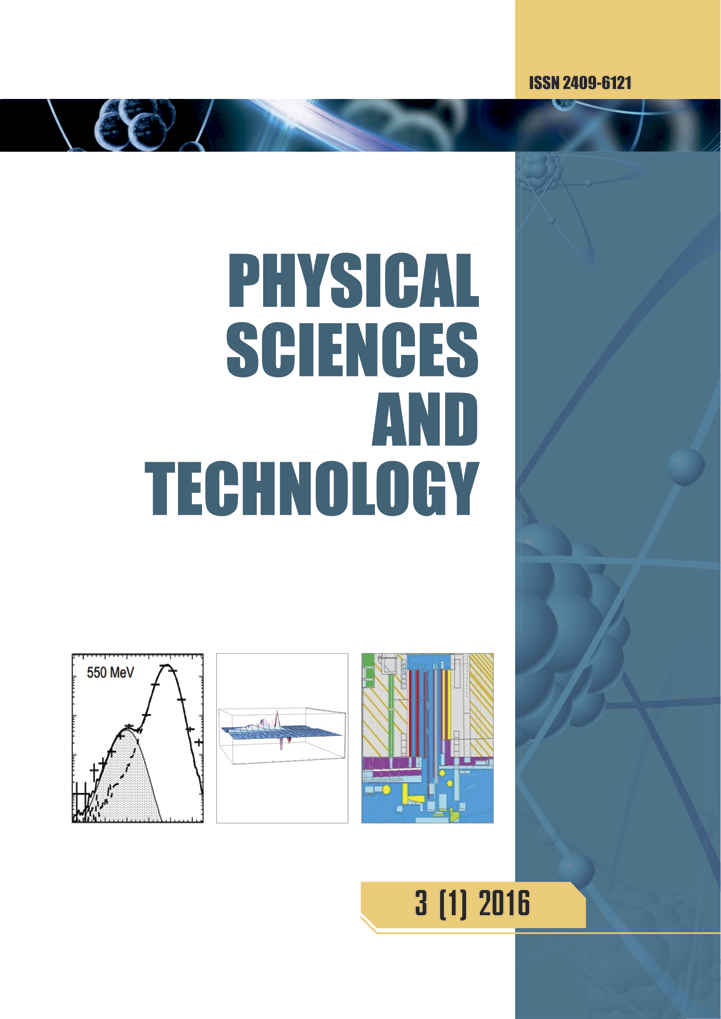Electrical conductivity of silicon quantum nanowires
DOI:
https://doi.org/10.26577/2409-6121-2015-2-1-37-43Keywords:
Key words, silicon, quantum nanowire, tunneling effect, hysteresis, nonlinear fractal. PACS numbers, 61.46.-w, 61.46.Km, 62.63.Hj, 73.63.-b.Abstract
We suggest a new theory for the description of electrical conductivity of semiconductor quantum nanowires. We take into account that oscillations of quantum nanowires lead to their self-similar deformation, and because of interaction between nanowires they form fractal clusters. Electrical potential of these structures is described via nonlinear fractal measures. We conclude that current-voltage characteristics of quantum nanowires contain hysteresis loops with oscillations. This fact corresponds to existence of negative differential resistance due to multi barrier tunneling effect in the described fractal structures.Our theoretical results have been confirmed by results of corresponding specific experimental study of nanoscale wire-like structures in silicon.References
[1] V. Sivakov, and S. Christiansen. Novel Discovery of Silicon // Journal of Nanoelectronics and Optoelectronics. – 2012. – Vol. 7. – P. 1-7.
[2] J.Zh. Chew, L. Lijie. A Discrete Memristor Made of ZnO Nanowires Synthesized on Printed Circuit Board // Material letters. – 2013. – Vol. 91. – P. 248-300.
[3] R. Zang, Sh.U. Yuldashev, J.C. Lee, V.Sh. Yalishev, T.W. Kang, D.J. Fu. Memristive behavior of ZnO/NiO stacked heterostructure // Microelectronic Engineering. – 2013. – Vol. 112. – P. 31-34.
[4] H.Y. Tsao, Y.J. Lin. Resistive Switching Behaviors of Au / Pentacene / Si-Nanowire Arrays / Heavily Doped n-type Si Devices for Memory Applications // Applied Physics Letters. – 2014. – Vol. 104. – Iss. 5. – P 053501.
[5] X. Li, P.W. Bohn. Metal-assisted chemical etching in HF / H2O2 produces porous silicon // Appl. Phys. Lett. – 2000. – Vol. 77. – P. 2572-1-5.
[6] Zh. Huang, N. Geyer, P. Werner, J. Boor, and Gцsele U. Metal-Assisted Chemical Etching of Silicon: A Review // Advanced Materials. – 2011. – Vol. 23. – P. 285.
[7] P.F. Bagwell, T.P Orlando. Landauer’s Conductance Formula and its Generalization to Finite Voltages // Phys. Rev. B. – 1989. – Vol. 40. – P. 1456.
[8] A. Mehonic], A. Vrajitaarea, S. Cneff, S. Hudziak, C. Labbe, R. Rizk, M. Pepper, and A.J. Kenyon. Quantum Conductance in Silicon Ovide Resistive Memory Devices // Scientific Reports / 3 : 2708 | DOI: 10.1038/srep02708. – 2013. – P. 1-8.
[9] Z.Zh. Zhanabaev, T.Yu. Grevtseva. Physical Fractal Phenomena in Nanostructured Semiconductors // Reviews in Theoretical Science. – 2014. – Vol. 2. – No 3. – P. 211-259.
[10] Z.Zh. Zhanabaev, T.Yu. Grevtseva, T.B. Danegulova, G.S. Assanov. Optical Processes in Nanostructured Semiconductors // Journal of Computational and Theoretical Nanoscience. – 2013. – Vol. 10. – No 3. – P.673-678.
[11] R. Juhasz, N. Elfstrom, J. Linnros. Controlled fabrication of silicon nanowires by electron beam lithography and electrochemical size reduction // Nano Lett. – 2005. – Vol. 5. – No 2. – P. 275-280.
[12] C.M. Hsu, S.T. Connor, M.X. Tang, Y Cui. Wafer-scale silicon nanopillars and nanocones by Langmuir-Blodgett assembly and etching // Appl. Phys. Lett. – 2008. – No 93. – P. 133109.
[13] R. Kцnenkamp, C. Robert. Word, and Schlegel C.Vertical nanowire light-emitting diode // Applied Physics Letters. – 2004. Vol. 85. – No 24. – P. 6004- 6008. [14] Ch. Lao, Li Yi, C.P. Wong, Z.L. Wang. Enhancing the Electrical and Optoelectronic Performance of Nanobelt Devices by Molecular Surface Functionalization // Nano Letters. – 2007. – Vol. 7, No 5. – P. 1323-1328.
[2] J.Zh. Chew, L. Lijie. A Discrete Memristor Made of ZnO Nanowires Synthesized on Printed Circuit Board // Material letters. – 2013. – Vol. 91. – P. 248-300.
[3] R. Zang, Sh.U. Yuldashev, J.C. Lee, V.Sh. Yalishev, T.W. Kang, D.J. Fu. Memristive behavior of ZnO/NiO stacked heterostructure // Microelectronic Engineering. – 2013. – Vol. 112. – P. 31-34.
[4] H.Y. Tsao, Y.J. Lin. Resistive Switching Behaviors of Au / Pentacene / Si-Nanowire Arrays / Heavily Doped n-type Si Devices for Memory Applications // Applied Physics Letters. – 2014. – Vol. 104. – Iss. 5. – P 053501.
[5] X. Li, P.W. Bohn. Metal-assisted chemical etching in HF / H2O2 produces porous silicon // Appl. Phys. Lett. – 2000. – Vol. 77. – P. 2572-1-5.
[6] Zh. Huang, N. Geyer, P. Werner, J. Boor, and Gцsele U. Metal-Assisted Chemical Etching of Silicon: A Review // Advanced Materials. – 2011. – Vol. 23. – P. 285.
[7] P.F. Bagwell, T.P Orlando. Landauer’s Conductance Formula and its Generalization to Finite Voltages // Phys. Rev. B. – 1989. – Vol. 40. – P. 1456.
[8] A. Mehonic], A. Vrajitaarea, S. Cneff, S. Hudziak, C. Labbe, R. Rizk, M. Pepper, and A.J. Kenyon. Quantum Conductance in Silicon Ovide Resistive Memory Devices // Scientific Reports / 3 : 2708 | DOI: 10.1038/srep02708. – 2013. – P. 1-8.
[9] Z.Zh. Zhanabaev, T.Yu. Grevtseva. Physical Fractal Phenomena in Nanostructured Semiconductors // Reviews in Theoretical Science. – 2014. – Vol. 2. – No 3. – P. 211-259.
[10] Z.Zh. Zhanabaev, T.Yu. Grevtseva, T.B. Danegulova, G.S. Assanov. Optical Processes in Nanostructured Semiconductors // Journal of Computational and Theoretical Nanoscience. – 2013. – Vol. 10. – No 3. – P.673-678.
[11] R. Juhasz, N. Elfstrom, J. Linnros. Controlled fabrication of silicon nanowires by electron beam lithography and electrochemical size reduction // Nano Lett. – 2005. – Vol. 5. – No 2. – P. 275-280.
[12] C.M. Hsu, S.T. Connor, M.X. Tang, Y Cui. Wafer-scale silicon nanopillars and nanocones by Langmuir-Blodgett assembly and etching // Appl. Phys. Lett. – 2008. – No 93. – P. 133109.
[13] R. Kцnenkamp, C. Robert. Word, and Schlegel C.Vertical nanowire light-emitting diode // Applied Physics Letters. – 2004. Vol. 85. – No 24. – P. 6004- 6008. [14] Ch. Lao, Li Yi, C.P. Wong, Z.L. Wang. Enhancing the Electrical and Optoelectronic Performance of Nanobelt Devices by Molecular Surface Functionalization // Nano Letters. – 2007. – Vol. 7, No 5. – P. 1323-1328.
Downloads
How to Cite
Zhanabaev, Z., Grevtseva, T., & Ibraimov, M. (2016). Electrical conductivity of silicon quantum nanowires. Physical Sciences and Technology, 2(1). https://doi.org/10.26577/2409-6121-2015-2-1-37-43
Issue
Section
Theoretical Physics and Astrophysics




